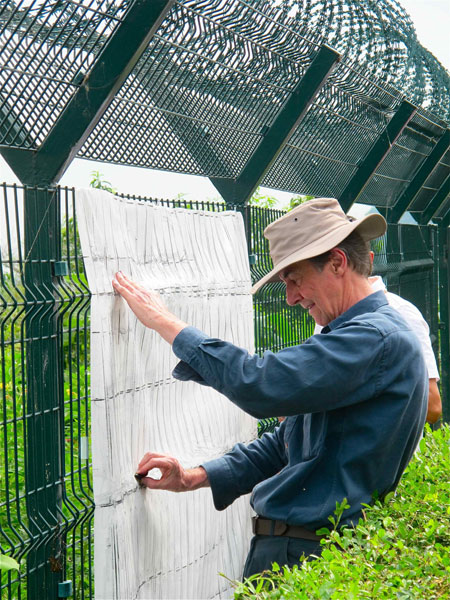Borderline Art
Updated: 2012-09-09 08:10
By Ian Lang (China Daily)
|
|||||||||||
|
Ian Howard has been stimulated by contemporary art in China. He says making art from the imagery from national borders is a way for "East and West to better know each other through creativity". Photo by Ian Lang / for China Daily |
Borders can sometimes become bridges, as our small academic party found in a preview of China's most northeastern edges. There were none of the clenched knuckles that are sometimes a physical reaction to barriers and barbed wire.
There's an art to these hills and their fences.
Working on a tiny sliver of land, separating the Democratic People's Republic of Korea, Russia and China, University of New South Wales art professor Ian Howard's urgent daubing is turning heads, and sometimes watchtower cameras. Politicians, not painters, usually mark the lines of these frontiers.
The works are rubbings, following ancient traditions but with a modern twist. Blank gallery-size canvases up to 4-meter long are impressed with wax and crayon, creating life-sized records of pivotal sites that define China's revolutionary past and evolving present.
Colleagues from Shenyang's Luxun Academy of Fine Arts help rub at 10 strategic sites more than 1,000 kilometers of China's border with the DPRK. Our journey takes two weeks, from the delta of the Yalu River up to the 1.8-kilometer high volcanic caldera of Tianchi Lake, sliding on down the Tumen River through vast forests to China's Russian frontier-town of Fangchuan village near Vladivostok.
Media images prepare us for razor wire and guns - and yes, they're there - but soon we discover new border cities too, bustling with curious Chinese and Russian tourists beneath canopies of microwave towers.
It's a fluid transition zone where armed boats from both Koreas play chicken with each other with almost ritual courtesy - provided neither crew sets foot on the other's bank. Farmers work rich soils on each side nonchalantly.
Borders are decided by man and nature. Rivers, mountains, and volcanoes often dictate terms. No wonder the permanence of inscribed stone tablets have been used over dynasties to mark Chinese history. Surviving war and disaster, scholars and artists have rubbed them ever since.
Dressed like a truck-driver true to his working-class childhood, Howard's pedigree in documenting modern demarcations has taken him from the Berlin Wall in 1968 to the Great Wall in 2000. He's rubbed US Air Force jets fresh from battle. On the way, his almost obsessive perseverance has earned the respect of defense gatekeepers from the Pentagon to China's Ministry of Defense, and his works collected by major Australian art museums.
"Military art illustrates histories not many get to see this close up," Howard notes, looking for defining edges of national identity through the flash-points.
The twisted metal of a bridge over the Yalu River bombed in the 1950s provides a key site. As he works rubbing steel jags, a newer bridge across the border carries slow-moving trains to Pyongyang, followed by a procession of hardy new three-wheeled agricultural vehicles. Chinese tourists jostle for better views of the art and the other side. Our hosts report binoculars on the other side seem keen to focus on the canvas too.
A tall lanky figure, Howard's character reflects an almost Confucian-style pragmatism, with a more independent Lao-Tse-like drive to understand nature at its most elemental. Remarkably, he seems more energetic now than when I first started making Asian art films with him 20 years ago. Maybe it's just that new cameras are getting lighter for both of us.
"Contemporary art in China - especially figurative painting - is among the most skilled in the world," Howard observes, citing a key reason that first brought him to China in 1994 as both artist and educator. "It's clear massive economic growth is creating powerful challenges for China to express its contemporary cultural identity beyond borders. The time's right for East and West to better know each other through creativity."
With a dream to "circumnavigate" its international borders, his rubbings may soon demystify little-known areas. After all, these borders might just be the world's most expensive national art.
Gallery showings of the works with accompanying video documentaries of the first installment of Borderline Art are expected later in 2012 at the Luxun Academy of Fine Art, Shenyang, in Liaoning province, and at Watters Gallery, Sydney in March-April 2013.
Hong-Kong-based Ian Lang is honorary professor of media at the University of Melbourne, and a visiting professor at the Beijing Film Academy.
Contact the writer at sundayed@chinadaily.com.cn.
Today's Top News
Rescuers race against time for quake victims
Telecom workers restore links
Coal mine blast kills 18 in Jilin
Intl scholarship puts China on the map
More bird flu patients discharged
Gold loses sheen, but still a safe bet
US 'turns blind eye to human rights'
Telecom workers restore links
Hot Topics
Lunar probe , China growth forecasts, Emission rules get tougher, China seen through 'colored lens', International board,
Editor's Picks

|

|

|

|

|

|






